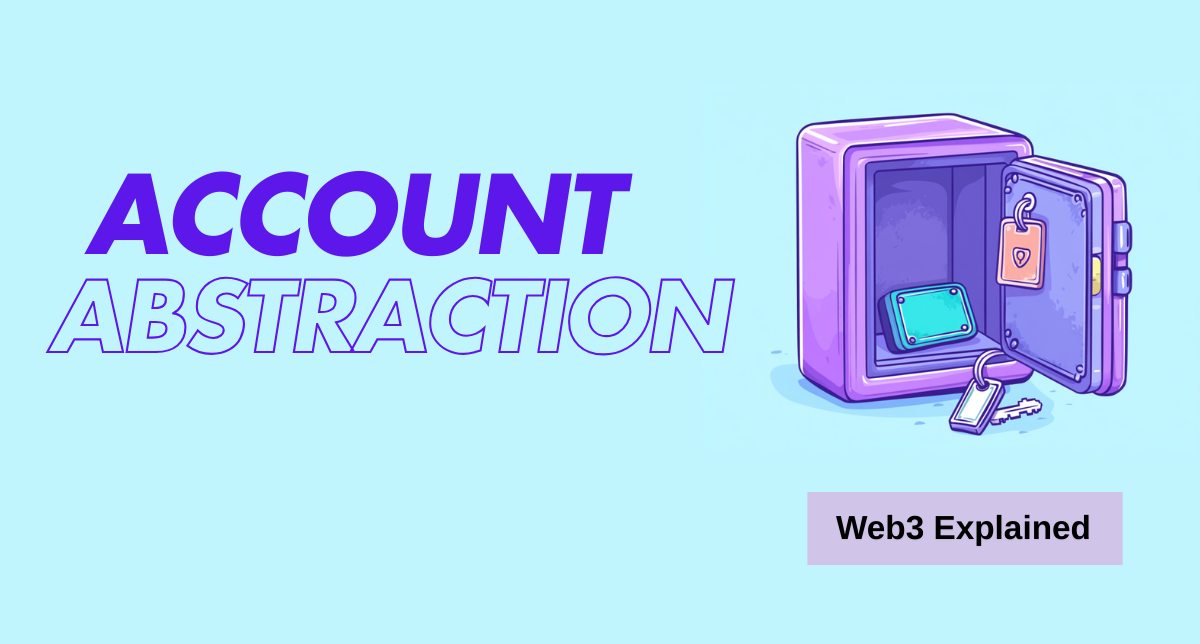As blockchain technology and cryptocurrency adoption evolve, developers continuously innovate to make crypto assets safer, more accessible, and easier to use. One of the latest and most talked-about innovations in blockchain is account abstraction. This concept, which aims to make interacting with blockchain networks more intuitive and flexible, holds the potential to improve user experience significantly. This guide will explore what account abstraction is, who developed it, its purpose, and how it works with examples that clarify its practical impact.
What is Account Abstraction?
In simple terms, account abstraction is a blockchain technology concept that aims to make user accounts (wallets) more programmable and flexible. Traditionally, there are two main types of accounts on Ethereum and many other blockchains:
- Externally Owned Accounts (EOAs): These are user accounts controlled by a private key. Transactions are initiated by users who control their accounts through private keys, like personal wallets.
- Contract Accounts: These are smart contracts deployed on the blockchain and are operated based on predefined code and rules. They do not have private keys and are instead triggered by EOAs.
In the current setup, EOAs are limited in functionality compared to contract accounts. Account abstraction changes this by merging the features of EOAs and contract accounts, allowing user accounts to behave more like programmable smart contracts. This change enables users to set custom rules and logic for their accounts, such as multisignature (multi-sig) security, social recovery mechanisms, and automated transaction handling.
Who Created Account Abstraction?
Account abstraction is not the work of a single individual but rather a community-driven effort primarily within the Ethereum ecosystem. Vitalik Buterin, Ethereum’s co-founder, has been one of the leading voices advocating for account abstraction, recognizing its potential to improve the usability and security of crypto wallets.
While the idea of account abstraction has been discussed since Ethereum’s early days, the Ethereum Foundation, along with various Ethereum developers, has been pushing forward the development of Ethereum Improvement Proposals (EIPs) focused on account abstraction. One notable proposal is EIP-4337, which was introduced to implement account abstraction without requiring changes to Ethereum’s core protocol. This proposal made it easier to integrate account abstraction on a broader scale within the Ethereum ecosystem, paving the way for more secure and user-friendly wallets.
Purpose of Account Abstraction
Account abstraction is designed to overcome the limitations of traditional EOAs, creating a more flexible and user-friendly experience on the blockchain. Here are some of the core objectives behind the concept:
- Improving User Experience: Current wallets are often challenging for beginners. Losing a private key means losing access to funds permanently. Account abstraction allows for mechanisms like social recovery, making it easier for users to recover their accounts.
- Enhanced Security: Account abstraction enables more advanced security features like multi-sig (requiring multiple signatures to authorize a transaction) and custom authorization logic, making it harder for unauthorized parties to access funds.
- Automated Transaction Processing: With programmable accounts, users can set predefined rules and logic for transactions. For instance, you could schedule periodic payments, automate recurring transfers, or authorize certain accounts to perform specific functions.
- Gasless Transactions: One of the key pain points in Ethereum is the need for gas fees to conduct transactions. With account abstraction, a wallet could be set up to pay gas fees in various tokens (or even allow third parties to sponsor transactions), improving user convenience.
- Compatibility with DeFi and dApps: Account abstraction allows developers to create wallets that can easily integrate with decentralized applications (dApps) and decentralized finance (DeFi) protocols, streamlining the user experience in interacting with complex smart contracts.
How Account Abstraction Works: Key Concepts and Examples
Account abstraction turns a user’s wallet into a smart contract-like account, allowing it to execute complex instructions based on custom rules set by the user. Here are a few examples to illustrate how account abstraction could work in practice:
1. Social Recovery Wallets
One of the common issues in crypto is the risk of losing a wallet’s private key. With account abstraction, users can set up a social recovery wallet. Here’s how it might work:
- Alice sets up her wallet with a social recovery feature. She designates her close friends Bob, Claire, and David as “guardians” who can help recover her account if she loses her private key.
- If Alice loses access to her wallet, she can initiate a recovery process. This process requires Bob, Claire, and David to confirm her identity.
- Once a majority of her guardians verify her identity, Alice regains access to her wallet, avoiding permanent loss of funds.
This social recovery mechanism makes it easier for users to regain access to their accounts without compromising security.
2. Multi-Signature Security
In some cases, users or organizations may want multiple people to authorize a transaction to enhance security. With account abstraction, users can create a multi-signature wallet that requires multiple private keys to sign off on a transaction. Here’s how:
- Bob sets up his wallet to require two out of three signatures for any transaction, involving his own key, his accountant’s key, and his partner’s key.
- When a transaction is initiated, at least two of these three keys must sign the transaction for it to be executed, reducing the risk of unauthorized access.
This multi-signature function is particularly useful for businesses and high-net-worth individuals who want to prevent unauthorized transactions from a single compromised key.
3. Automated Transactions and Subscriptions
With account abstraction, users can create wallets that execute transactions automatically based on predefined conditions. For example:
- Sarah sets up her account to make monthly payments to a decentralized storage provider.
- She creates a rule in her account that initiates a transaction every 30 days, automatically transferring the required amount from her wallet to the provider.
This type of functionality could make subscriptions and recurring payments much more straightforward, similar to automated payments in traditional finance.
4. Gas Fee Flexibility
Traditional Ethereum accounts require ETH for gas fees, which can be inconvenient for users holding other tokens. With account abstraction, users could set their accounts to pay gas fees using other ERC-20 tokens or enable third-party gas sponsorship:
- John’s account is configured to pay gas fees with USDC instead of ETH.
- Alternatively, a dApp could sponsor John’s transaction fees, allowing him to interact with the application without holding any ETH.
This flexibility reduces friction and makes blockchain technology more accessible, especially for new users unfamiliar with gas fees.
The Impact of EIP-4337 on Account Abstraction
EIP-4337 is a critical proposal for implementing account abstraction without changing Ethereum’s core protocol. Instead of modifying the consensus layer, this proposal introduces a new layer for “user operations.” This setup allows users to interact with the blockchain using programmable accounts and enables developers to build more complex wallets without altering Ethereum’s core infrastructure.
EIP-4337 uses bundlers—entities responsible for grouping multiple user operations and submitting them as a single transaction. This technique helps reduce gas costs and streamline operations, making account abstraction a more practical and scalable solution on Ethereum.
Benefits and Future of Account Abstraction
Account abstraction represents a significant step forward in user-friendly and secure blockchain interactions. The benefits of account abstraction include:
- Better Account Security: Enhanced security features like multi-sig, social recovery, and custom authentication make accounts safer.
- Enhanced User Experience: With the ability to recover accounts, automate transactions, and pay gas fees in different tokens, account abstraction could greatly simplify the crypto experience.
- Increased Adoption Potential: By reducing the complexity of managing a crypto account, account abstraction could encourage more people to enter the blockchain space.
Conclusion
Account abstraction is a powerful innovation that has the potential to redefine how people interact with blockchain. By making user accounts more flexible, programmable, and secure, account abstraction addresses many of the challenges that have hindered the mass adoption of crypto. As developers continue to refine account abstraction and integrate it with Ethereum and other blockchain ecosystems, we may soon see wallets that are as user-friendly as traditional banking applications, but with the added benefits of decentralization and security.
With account abstraction, the future of blockchain wallets looks bright, promising a user experience that balances security, flexibility, and accessibility—key elements for driving the next wave of blockchain adoption.

A.k.a – alpha girl. Vinita is the founder of Alphachaincrypto. An English Lit Majors, Vinita bumped into Web3 in 2020 only to realise that tech was her calling. Later, Mathreja worked for some notable brands like Near Education, Biconomy, CoinDCX and top of the line crypto start ups.





